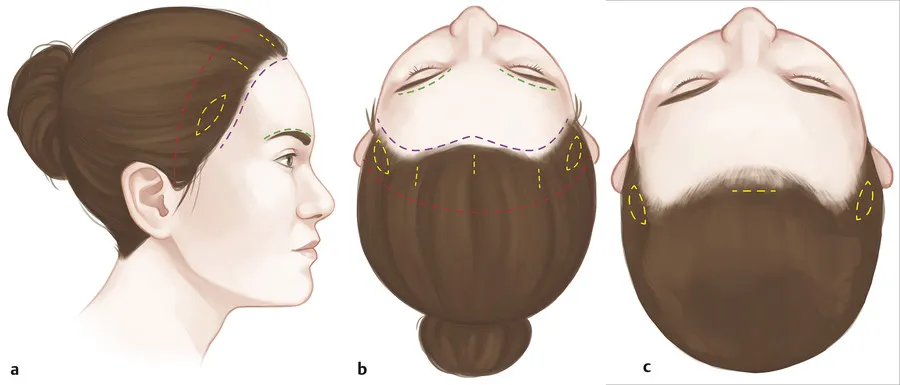Endoscopic forehead lift in Iran and forehead lift
Endoscopic forehead lift in Iran is a modern and less invasive method to improve forehead and nose wrinkles. In this method, instead of one long incision in the head, several small incisions are made in the head. A small device called an endoscope—which has a camera and light—is then inserted into these incisions so the surgeon can see the tissues beneath the skin.
Forehead lift is a type of surgery that is used to improve forehead wrinkles. In this procedure, the skin and underlying tissues of the forehead are stretched to reduce forehead wrinkles and make the forehead look younger.
before the operation
Before this operation, you should consult your doctor and get complete information from him about all aspects of this operation. Your doctor should review your medical history and ask you to stop certain medications before the procedure.
during the operation
This procedure is usually performed under general anesthesia. Your doctor will first make a few small incisions in your head. Then he uses these incisions to pull the skin and underlying tissues of your forehead. This procedure may take about 1 to 2 hours.
After the operation
After the procedure, you may experience some side effects such as bleeding, infection, swelling, bleeding, numbness or itching, changes in skin sensation, nerve damage, or abnormal skin wrinkling. It may take several weeks or months for full recovery.
Summary
A forehead lift is a surgical procedure that can make you look younger, but like any other surgical procedure, it has its own risks. Therefore, before deciding to do this procedure, consult your doctor and be aware of all aspects of this procedure.
Types of forehead lift methods
The two main methods for forehead lift include “open forehead lift” and “endoscopic forehead lift in Iran”. Both of these methods provide improvement of forehead wrinkles and increase of stiff and tired eyes.
Open forehead lift
In this procedure, an incision is made from one ear to the other at the top of the head, usually through the hair. The skin is then removed to access the underlying tissues. The underlying tissues and muscles are then improved or removed to reduce wrinkles. The skin is then stretched, the excess cut off and sewn back together.
Endoscopic forehead lift in Iran
This method requires less incisions and as a result there is less damage to the skin and tissue. In this procedure, several small incisions are made in the head and an endoscope (a device with a small camera at the head) is inserted into the incisions. Using an endoscope, the doctor can see the tissues under the skin and correct them. Then the skin is stretched and the incisions are sutured.
Both methods have their own advantages and disadvantages. An open forehead lift may have more permanent results, but requires a longer recovery time and is more likely to cause scarring. An endoscopic forehead lift has a shorter recovery time and less scarring, but the results may last a shorter time. A discussion with your doctor can help you choose the best method for your specific needs.
Endoscopic forehead lift in Iran
Endoscopic forehead lift surgery is a modern and less invasive method to improve forehead and nose wrinkles. In this method, instead of one long incision in the head, several small incisions are made in the head. A small device called an endoscope—which has a camera and light—is then inserted into these incisions so the surgeon can see the tissues beneath the skin.
In this way, the surgeon can correct the tissues and muscles that cause wrinkles. The skin is then precisely stretched to reduce wrinkles and give your forehead a more youthful appearance. The incisions are then closed with small stitches.
The advantages of endoscopic forehead lift in Iran include the following:
– Less scarring than more traditional methods
– Shorter recovery time
– Less visible as the incisions are usually hidden in the hair
– Less likely to cause swelling and bleeding
However, like any other surgical procedure, this procedure has its own risks and complications, including the possibility of infection, bleeding, swelling, changes in skin sensation, or the need for additional operations. To help you make a better decision, talk to your doctor about all aspects of this surgery.

Endoscopic forehead lift in Iran procedure
Endoscopic forehead lift is a surgery that is performed using an endoscope. This is a small device that uses a camera and light to see internal tissues. Below you can see how to perform this surgery:
1. Preparation: Before the operation, the patient is anesthetized for a short time. The scalp is washed and disinfected.
2. Incisions: The surgeon makes several small incisions (usually between 3 and 5) on the forehead or in the hairline.
3. Endoscopy: An endoscope is inserted through these incisions. This allows the surgeon to see the tissue beneath the skin.
4. Tissue correction: Using special tools, the surgeon corrects the muscles and tissues that cause wrinkles or laugh lines.
5. Skin stretching: The forehead skin is precisely stretched to reduce wrinkles.
6. Closing the incisions: The incisions are closed using small stitches. These stitches are usually removed after a few days.
7. Recovery: The patient is transferred to a rest room and can return home after the anesthesia wears off. Recovery time varies, but is usually between one and two weeks.
However, this process may vary depending on the specific surgeon, patient and their specific needs. Always talk to your doctor about what to expect and how you can get the most out of your surgery.
Cost and price of endoscopic forehead lift in Iran
The cost of endoscopic forehead lift surgery in Tehran 2024
(Endoscopic eyebrow lift surgery, endoscopic temple lift is also similar to this surgery)
- The cost of endoscopic forehead lift surgery in Tehran is between 1500 to 2500 euros
- Usually one night stay in the hospital is considered
- If you are not a resident of Tehran, the duration of stay in Tehran is 6 days
The cost of endoscopic forehead lift surgery in Tehran |
1500 euros |
including surgeon + hospital fee | |
| Other costs related to endoscopic forehead lift surgery in Tehran | |||
| Cost of blood test | Between 10 and 15 euros | The difference depends on the type of blood test | |
| The cost of consultation with a cardiologist | Between 20 and 40 euros | For people over 40 or heart patients | |
| The cost of medicine and other health items | Between 10 and 20 euros | ||
| Forehead lift plastic surgery cost – optional | |||
| Nurse fee (per night) | 30 euros | If you are traveling alone | |
| The cost of changing the dressing by the nurse | |||
Attention:
- If you have an underlying disease or medication, let us know
- If you have already operated on the forehead, the cost of the surgery will increase slightly
- Let us know if you have anemia or other blood disorders
Recovery stages after endoscopic forehead lift
The stages of recovery after endoscopic forehead lift surgery are different and depend on the individual condition of each patient. However, below is a summary of what you can expect:
1. The first days after the operation: at this time, there may be swelling and bruising. Some patients may feel tightness or pressure in their forehead. These symptoms are normal and should subside within a few days or weeks.
2. Week 1 to 2: During this period, swelling and bruising should decrease. Some patients may be able to return to work and daily activities, but others may need a longer period of rest.
3. The following weeks: During this period, most symptoms should be completely gone. Some patients may still feel sensitivity or numbness in areas of their forehead, but these symptoms should gradually subside.
4. The following months: At this time, the final results of the surgery should appear. Your forehead skin should look smoother and younger.
Never forget that each patient responds to surgery individually and may need a different amount of time to fully recover. Always talk to your doctor about any concerns or questions you have.
Incisions in endoscopic forehead lift in Iran
In endoscopic forehead lift surgery, incisions are usually made in the scalp, in different parts of the forehead. These incisions are usually small (about 1 inch or less) and small enough to be covered by your hair.
In this surgery, the surgeon uses 3 to 5 small incisions. Each incision is used as an access point for endoscopes and surgical instruments. An endoscope is a small camera with a light that allows the surgeon to see the tissues under the skin, and the instruments allow the surgeon to manipulate the tissues.
After surgery, the incisions are closed with stitches or staples. Depending on the type of stitches and the surgeon’s decision, these stitches may be removed after a few days or weeks.
One of the advantages of an endoscopic forehead lift is that the incisions are small, resulting in fewer side effects such as scars, infections, and numbness. Also, they require less recovery.

Durability of endoscopic forehead lift in Iran
The longevity of endoscopic forehead lift results depends on several factors, including your age, your lifestyle, and genetics. Overall, the results may last for years or even decades.
On the other hand, lifestyle changes can help maintain the results of surgery. These changes can include maintaining a healthy weight, avoiding smoking, protecting the skin from the sun, and using the right skin care products.
The difference between endoscopic forehead lift and endoscopic temple lift
Endoscopic forehead lift and endoscopic temple lift are two different types of endoscopic lift surgeries, each of which is performed for specific purposes. The two methods differ in where and how they are applied:
1. Endoscopic forehead lift in Iran: This type of lift is mainly used to reduce wrinkles and deep lines on the forehead. Some people may also use this method to remove drooping eyebrows. In this surgery, incisions are usually made in the scalp above the forehead.
2. Endoscopic temple lift: This type of lift is performed to improve the appearance of the temple, which may have sagging due to aging, genetic changes or damage. In this surgery, incisions are usually made around the ear or in the hair of the head in the temple area.
In both types of surgery, the surgeon uses an endoscope, a device with a small camera that allows him to see and make adjustments to the tissues under the skin. Both methods have their advantages, and your doctor can help you decide which one is best for your needs.

